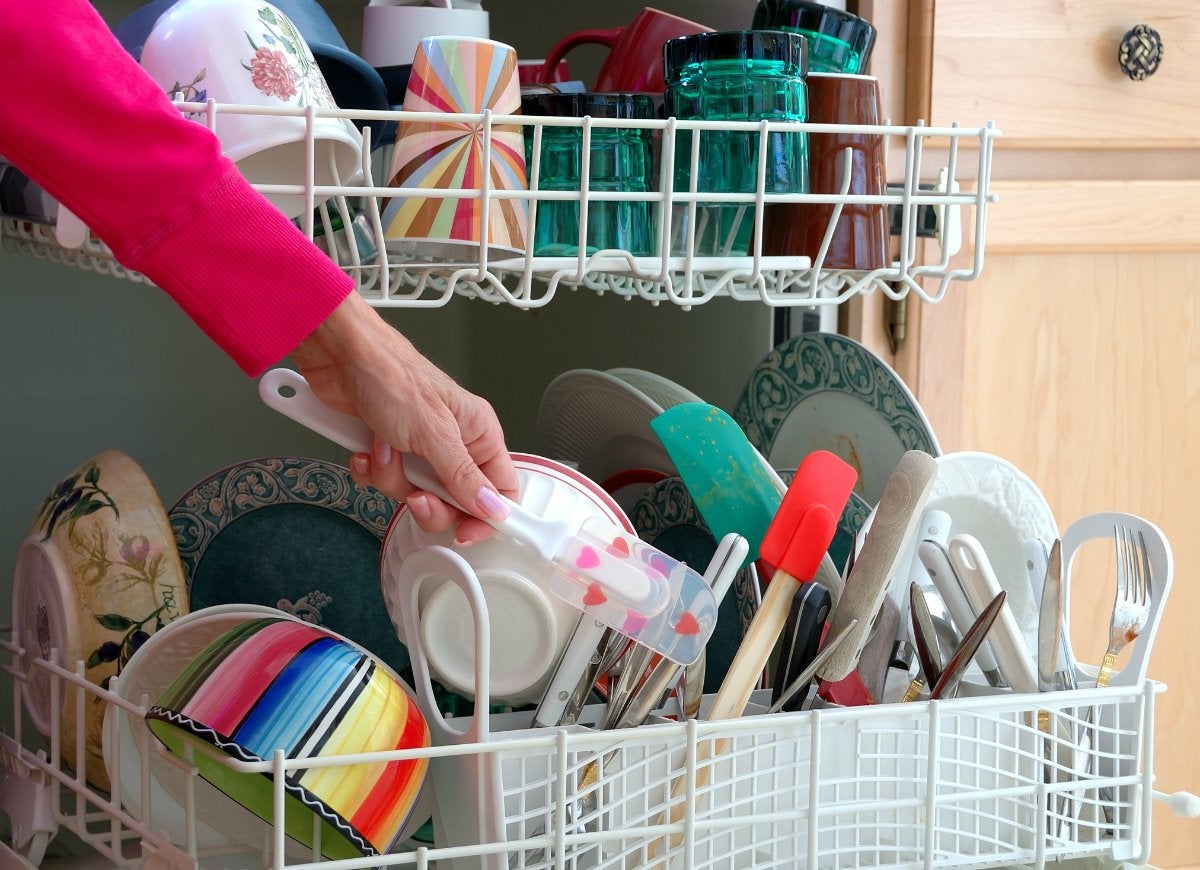Home>Interior Design>Dishwasher Mistakes Experts Urge You To Avoid


Interior Design
Dishwasher Mistakes Experts Urge You To Avoid
Modified: August 20, 2024
Avoid these common dishwasher mistakes recommended by experts to maintain the interior design of your kitchen.
(Many of the links in this article redirect to a specific reviewed product. Your purchase of these products through affiliate links helps to generate commission for Storables.com, at no extra cost. Learn more)
Introduction
When it comes to maintaining a clean and efficient kitchen, a dishwasher can be a game-changer. The convenience of popping dirty dishes in and letting the machine do the work is hard to beat. However, even with the advances in dishwasher technology, there are common mistakes that many people make when it comes to using this essential kitchen appliance.
In this article, we will explore ten common dishwasher mistakes that experts urge you to avoid. By being aware of these mistakes and correcting them, you can ensure that your dishwasher operates at its peak efficiency, prolong its lifespan, and achieve spotless, sparkling dishes every time.
Whether you are a novice or a seasoned dishwasher user, read on to discover the dos and don’ts of dishwasher usage and maintenance.
Key Takeaways:
- Avoid overloading your dishwasher to ensure proper cleaning and prevent damage. Give each dish breathing room and follow loading guidelines for sparkling results and prolonged appliance lifespan.
- Use the correct detergent, rinse aid, and temperature settings for spotless dishes. Regularly clean the filter and perform maintenance tasks to keep your dishwasher running smoothly and efficiently.
Overloading the Dishwasher
One of the most common mistakes people make is overloading the dishwasher. It can be tempting to fit as many dishes as possible to save time and energy, but doing so can have negative consequences.
Overloading the dishwasher can result in improper cleaning and rinsing. When dishes are packed too tightly together, the water and detergent may not be able to reach every surface, leaving behind food particles and residue. Furthermore, overcrowding can restrict the movement of the spray arms, preventing them from efficiently spraying water to clean the dishes.
To avoid this mistake, be mindful of the dishwasher’s capacity guidelines and leave enough space for water and detergent to circulate freely. This will ensure that each dish receives adequate cleaning and rinsing, leading to optimal results.
Additionally, overloading the dishwasher can put strain on the appliance itself. The excess weight and pressure can lead to damage, such as broken racks or malfunctioning parts. By following the dishwasher’s recommended guidelines for loading, you can help prolong its lifespan and avoid costly repairs.
In summary, resist the temptation to pack your dishwasher to its limit. Give each dish breathing room and follow the manufacturer’s loading instructions for a properly cleaned and efficient dishwasher.
Not Scraping Off Food Residue
One of the most important steps before loading your dishes into the dishwasher is to scrape off any excess food residue. Many people overlook this step and assume that the dishwasher will take care of it. However, not removing food particles can lead to poor cleaning results and even clog the dishwasher over time.
When food debris is left on plates, utensils, and cookware, it can become dried and hardened during the wash cycle. This can create a barrier, preventing the water and detergent from effectively reaching the surfaces that need to be cleaned. As a result, dishes may come out of the dishwasher still dirty or with residue clinging to them.
To avoid this issue, take a few seconds to scrape off any visible food residue into the garbage or compost bin before placing the dishes in the dishwasher. This simple step can greatly improve the overall cleanliness of your dishes and prevent any unwanted clogs or buildup in the dishwasher.
In addition to scraping off food residue, it is also recommended to rinse dishes that have particularly stubborn or sticky debris. Items like pots, pans, and baking sheets with baked-on food should be soaked or hand-washed to remove as much residue as possible before being loaded into the dishwasher.
By taking the time to properly prepare your dishes, you can ensure that your dishwasher can effectively do its job and provide you with spotless results every time.
Using the Wrong Detergent
Choosing the right detergent for your dishwasher is essential for achieving clean and streak-free dishes. Using the wrong detergent can lead to poor cleaning performance, residue buildup, and even damage to your dishwasher.
One common mistake is using regular dish soap or handwashing detergent in the dishwasher. These types of detergents create too much foam and can result in a messy overflow from the dishwasher. Additionally, they may not have the necessary enzymes and surfactants to effectively remove food particles and stains from dishes.
Instead, it is important to use dishwasher-specific detergents that are formulated for the machine’s high temperature and water pressure. These detergents are designed to dissolve food particles and grease, prevent spotting and streaking, and leave your dishes sparkling clean.
When choosing a dishwasher detergent, consider factors such as your water hardness, the type of dishwasher (standard or compact), and any specific cleaning needs you may have (such as eco-friendly or fragrance-free options).
It is also recommended to use rinse aid in conjunction with your dishwasher detergent. Rinse aid helps to prevent water spots and enhance drying performance, resulting in spotless and dry dishes.
By using the correct detergent and rinse aid, you can optimize the cleaning power of your dishwasher and maintain the longevity of both the appliance and your dishes.
Improper Loading of Utensils
Properly loading utensils in the dishwasher may seem like a straightforward task, but it is a step that is often overlooked or done incorrectly. Failing to load utensils properly can lead to ineffective cleaning and potential damage to both the utensils and the dishwasher.
One common mistake is placing utensils with handles facing down. This can prevent proper cleaning and rinsing, as the water and detergent may not be able to reach the food particles stuck on the handle or in the crevices. Instead, it is recommended to load utensils with handles facing up. This ensures that the water can freely flow and reach all areas of the utensils.
Another common mistake is grouping similar utensils together in the utensil basket. Forks, spoons, and knives should be spaced out to allow for proper cleaning and to prevent them from nesting or sticking together during the wash cycle. Nesting utensils can prevent the spray arms from spinning freely and result in dirty and spotted utensils.
Additionally, knives should be loaded with the sharp end facing down to prevent injury when unloading the dishwasher. Be cautious when loading sharp knives and ensure that they are securely placed to avoid any accidents.
When it comes to loading utensils, it is also important to avoid overcrowding. Overcrowding can inhibit the water and detergent from reaching all surfaces of the utensils, leading to ineffective cleaning. Give each utensil enough space to ensure optimal cleaning and prevent nesting.
By following these loading guidelines and giving attention to how you place your utensils, you can maximize the cleaning efficiency of your dishwasher and reduce the risk of damage to both your utensils and the appliance.
Incorrect Dishwasher Temperature
Setting the correct temperature on your dishwasher is crucial for achieving clean and sanitized dishes. Many dishwashers offer different temperature options, such as normal, heavy-duty, or eco-friendly cycles. Choosing the wrong temperature can impact the effectiveness of the cleaning process and the overall hygiene of your dishes.
One common mistake is using lower temperature settings for heavily soiled dishes. While eco-friendly or energy-saving modes may be tempting to use, they may not provide enough heat to effectively remove stubborn food particles and bacteria. It is recommended to use higher temperature settings, such as the heavy-duty or sanitize cycles, for greasy or heavily soiled dishes to ensure proper cleaning and sanitization.
On the other hand, using high-temperature settings for delicate glassware or plastics can lead to damage. Excessive heat can cause warping, cracking, or melting of delicate items. Be mindful of the materials you are loading into the dishwasher and adjust the temperature settings accordingly.
It is also worth noting that some dishwasher models have a booster heater feature. This feature raises the water temperature to ensure thorough cleaning and sanitization. If your dishwasher has this feature, make sure it is activated to achieve optimal cleaning results.
In addition to selecting the appropriate temperature, it is essential to maintain the temperature of your hot water supply to the dishwasher. Hot water helps to activate the detergent and remove grease and food particles effectively. Make sure your hot water heater is set to a temperature of at least 120°F (49°C) to ensure adequate cleaning performance.
By using the correct temperature settings and maintaining the temperature of your hot water supply, you can ensure that your dishes are thoroughly cleaned, sanitized, and free from harmful bacteria and residue.
To avoid dishwasher mistakes, always scrape off excess food before loading, use the right detergent, and leave space between dishes for proper water circulation.
Neglecting to Clean the Filter
One important maintenance task that is often overlooked is cleaning the filter in your dishwasher. The filter plays a crucial role in trapping food particles, debris, and other contaminants that would otherwise recirculate in the dishwasher, leading to poor cleaning performance and potential damage to the appliance.
The filter is typically located at the bottom of the dishwasher, under the lower spray arm. Over time, it can become clogged with food residue, grease, and other debris, hindering water flow and preventing proper drainage. Failure to clean the filter regularly can result in reduced cleaning effectiveness, unpleasant odors, and even dishwasher malfunctions.
To clean the filter, remove the lower spray arm and locate the filter assembly. It usually consists of a coarse filter and a fine mesh filter. Remove any visible debris by hand or use a soft brush or toothbrush to gently scrub away stubborn residue. Rinse the filters under running water to remove any remaining particles.
It is recommended to clean the filter at least once a month or more frequently if your dishwasher is heavily used or if you notice a decrease in cleaning performance. Regularly cleaning the filter will ensure that water can flow freely, and the dishwasher can effectively remove food particles and maintain its optimal cleaning efficiency.
In addition to cleaning the filter, it is also important to regularly inspect and clean the spray arms. Food particles and mineral deposits can clog the spray arm nozzles, reducing their ability to spray water effectively. Use a toothpick or a small brush to unclog the nozzles and remove any debris.
By regularly cleaning the filter and spray arms, you can ensure that your dishwasher operates at its best, providing you with clean and spotless dishes after every wash cycle.
Loading Non-Dishwasher Safe Items
It can be tempting to toss everything into the dishwasher for quick and convenient cleaning. However, loading items that are not dishwasher safe can result in damage to both the item and your dishwasher.
Non-dishwasher safe items include certain types of plasticware, delicate glassware, wooden utensils, and items with adhesive labels. These items may warp, crack, melt, or become discolored when exposed to the high temperatures and intense water pressure inside the dishwasher.
Before loading any item into the dishwasher, always check the manufacturer’s guidelines or labels to ensure their dishwasher compatibility. If an item is not dishwasher safe, it is best to wash it by hand using gentle soap and lukewarm water.
It is also worth noting that some items may have specific recommendations for placement in the dishwasher. For example, delicate glassware may require a top rack placement to avoid being jostled or damaged by the spray arm or other dishes.
To prolong the lifespan of your dishwasher and prevent damage to your belongings, take the extra time to hand wash any non-dishwasher safe items. By doing so, you can avoid potential mishaps and keep both your dishwasher and your items in excellent condition for years to come.
Using Too Much Rinse Aid
Rinse aid is a valuable addition to your dishwasher routine. It helps to improve drying performance and prevent water spots and streaks on your dishes. However, using too much rinse aid can lead to its own set of problems.
One common mistake is pouring an excessive amount of rinse aid into the dishwasher dispenser. While it may seem like more is better, using too much rinse aid can result in a sticky residue on your dishes and the interior of the dishwasher. This can leave a film or cloudiness on your glassware and make it difficult to achieve a truly clean and spotless finish.
To avoid this issue, follow the manufacturer’s recommendations on the amount of rinse aid to use. Most dishwasher models have a rinse aid dispenser that can be adjusted to control the amount dispensed during each cycle. Start with the lowest setting and gradually increase if necessary to find the optimal amount for your dishwasher and water hardness level.
In addition to using the correct amount of rinse aid, it is important to regularly refill the dispenser to ensure consistent drying performance. Running out of rinse aid mid-cycle can result in poor drying results and the potential for water spots and streaks.
If you notice a buildup of residue or cloudiness on your dishes, it may be a sign that you are using too much rinse aid. In this case, clean the interior of the dishwasher and reduce the amount of rinse aid used for future cycles.
By using the appropriate amount of rinse aid, you can enhance the drying performance of your dishwasher and enjoy sparkling clean dishes without any unwanted residue or streaks.
Not Running Full Loads
Running your dishwasher with a full load is not only more efficient but also helps to conserve energy and water. Yet, it is a mistake that many people make – running the dishwasher with partial loads or even just a few items.
Running your dishwasher when it is not full wastes energy and water resources. The dishwasher uses the same amount of energy and water regardless of the load size. By running your dishwasher with partial loads, you are effectively using more resources per item cleaned.
Instead of running your dishwasher multiple times throughout the day with small loads, wait until you have a full load. This ensures that you are maximizing the energy and water efficiency of each cycle.
Additionally, running your dishwasher with a full load allows dishes to be properly positioned and spaced out, ensuring that water and detergent can access all surfaces for thorough cleaning. When there are only a few items in the dishwasher, they may not be positioned optimally, and water may not reach all areas, resulting in less effective cleaning.
If you frequently find yourself with small loads of dishes, consider using the “eco” or “half load” setting on your dishwasher if it has one. These settings are designed to adjust the water and energy usage according to the load size, maximizing efficiency even with smaller loads.
By running your dishwasher with full loads, you can save energy, water, and ultimately reduce your utility bills while still achieving clean and sparkling dishes.
Neglecting Regular Maintenance
Maintaining your dishwasher is crucial for its optimal performance and longevity. Unfortunately, many people neglect regular maintenance tasks, resulting in reduced cleaning efficiency, unpleasant odors, and potential breakdowns. Here are some key maintenance tasks that you shouldn’t overlook:
- Clean the interior: Over time, detergent residue, food particles, and grease can accumulate on the walls, racks, and door of the dishwasher. Regularly wipe down the interior with a damp cloth or sponge to prevent buildup and remove any potential sources of odor.
- Check and clean the spray arms: The spray arms distribute water to clean your dishes. Inspect them regularly for clogs caused by food debris or mineral deposits. Clean the spray arms using a toothpick or small brush to ensure optimal water flow and spray patterns.
- Inspect and clean the door gasket: The door gasket forms a seal to prevent water from leaking out of the dishwasher. Check it regularly for signs of mold, mildew, or debris. Clean the gasket with a mild solution of water and vinegar to remove any buildup and ensure a proper seal.
- Check and clean the dishwasher filter: As mentioned earlier, the dishwasher filter traps food particles and debris. Regularly remove and clean the filter to prevent clogs and maintain optimal cleaning performance.
- Run vinegar or dishwasher cleaner: Over time, mineral deposits can accumulate in your dishwasher, affecting its performance. Running a cycle with distilled white vinegar or a dishwasher cleaner can help dissolve these deposits and keep your dishwasher running smoothly.
- Inspect and clean the drainage system: Check the dishwasher’s drainage system for any clogs or blockages. Remove any debris or food particles from the drain or drainage hose to prevent backups and ensure proper drainage.
By incorporating these maintenance tasks into your routine, you can keep your dishwasher in top condition, prolong its lifespan, and ensure that it provides you with clean, spotless dishes every time.
Conclusion
A dishwasher can be a convenient and time-saving appliance in any kitchen. However, there are common mistakes that can hinder its performance and impact the cleanliness of your dishes. By being aware of these mistakes and taking proactive steps to avoid them, you can ensure that your dishwasher operates at its best and delivers sparkling clean results.
Avoid overloading the dishwasher and give each dish enough space to ensure proper cleaning and rinsing. Take the time to scrape off food residue before loading the dishes to prevent clogs and achieve optimal cleaning results.
Choosing the right detergent and using the correct amount of rinse aid are essential for effective cleaning and spotless dishes. Load utensils properly, ensuring that handles face up, and avoid overcrowding to allow for thorough and efficient cleaning.
Pay attention to the dishwasher temperature settings and use higher temperatures for heavily soiled dishes while protecting delicate items from excessive heat. Don’t forget to clean the filter regularly to maintain optimal performance and prevent odors.
Lastly, be mindful of loading only dishwasher-safe items and running full loads to conserve energy and water. Regular maintenance tasks such as cleaning the interior, spray arms, door gasket, and drainage system will keep your dishwasher running smoothly.
By avoiding these common dishwasher mistakes and implementing proper care and maintenance, you can enjoy the convenience and efficiency of your dishwasher while ensuring consistently clean and sanitized dishes for years to come.
Frequently Asked Questions about Dishwasher Mistakes Experts Urge You To Avoid
Was this page helpful?
At Storables.com, we guarantee accurate and reliable information. Our content, validated by Expert Board Contributors, is crafted following stringent Editorial Policies. We're committed to providing you with well-researched, expert-backed insights for all your informational needs.














0 thoughts on “Dishwasher Mistakes Experts Urge You To Avoid”